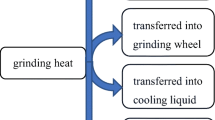Abstract
Grind-hardening is a new technical principle, which can implement surface hardness directly by the composite process of thermal load and mechanical force during the grinding process. The hardness changes on hardening layer are a significant impact on the surface integrity of the workpiece, fatigue strength, and wear resistance. Therefore, studies on hardening layer hardness and uniformity mechanism for the workpiece play a practical engineering significance. In this paper, an experiment of grind-hardening on 45 steel is done as a research subject. The workpiece microstructure is observed and surface hardness is measured firstly. Then, further analysis of the changes of the surface hardness and grinding parameters’ impact on the hardness are studied. Hardness uniformity of the mechanism of the hardening layer is studied emphatically in the paper. Finally, finite element method, combined with the hardness superposition principle, is applied to simulate the temperature distribution and transient temperature changes and predict the hardening layer hardness during the grinding process. The simulation results were verified by experiments.
Similar content being viewed by others
References
Xiu SC, Cai GQ, Li CH (2006) Study on dynamic strength model of contact layer in quick-point grinding. Key Eng Mater 304(305):570–575
Stohr R, Heinzel C (2002) Grinding-hardening with CBN. Abras Mag 6:22–30
Li CH, Hou YL, Liu ZR, Ding YC (2011) Investigation into temperature field of nano-zirconia ceramics precision grinding. Int J Abras Technol 4(1):77–89
Brinksmeier E, Brockhoff T (1999) Surface heat treatment by using advanced grinding processes. Metall Ital 91(4):19–23
Brockhoff T, Brinksmeier E (1999) Grind-hardening: a comprehensive view. CIRP Ann Manuf Technol 48(1):255–260
Xiu SC, Liu MH, Zhang XM, Wei JH (2015) Study on grinding strengthening and hardening mechanism under small depth of cut conditions. Int J Surf Sci Eng 9(6):479–492
Nguyen T, Zhang LC (2010) Grinding-hardening using dry air and liquid nitrogen: prediction and verification of temperature fields and hardened layer thickness. Int J Mach Tools Manuf 50:901–910
Xiu SC, Shi XL (2015) Transformation mechanism of microstructure and residual within hardening layer in PSHG. J Adv Mech Des Syst Manuf 9(3):1–13
Foeckerer T, Zaeh MF, Zhang OB (2013) A three-dimensional analytical model to predict the thermo-metallurgical effects within the surface layer during grinding and grind-hardening. Int J Heat Mass Transf 56:223–237
Alonso U, Ortega N, Sanchez JA, Pombo I, Izquierdo B, Plaza S (2015) Hardness control of grind-hardening and finishing grinding by means of area-based specific energy. Int J Mach Tools Manuf 88:24–33
Salonitis K, Stavropoulos P, Kolios A (2014) External grind-hardening forces modeling and experimentation. Int J Adv Manuf Technol 70:523–530
Alonso U, Ortega N, Sanchez JA, Pombo I, Plaza S, Izquierdo B (2014) In-process prediction of the hardened layer in cylindrical traverse grind-hardening. Int J Adv Manuf Technol 71:101–108
Joseph J, Martell C, Liu R, Shi J (2014) Experimental investigation on variation of machined residual stresses by turning and grinding of hardened AISI 1053 steel. Int J Adv Manuf Technol 74:1381–1392
Liu SY, Yang G, Zheng JQ (2015) Numerical and experimental studies on grind-hardening cylindrical surface. Int J Adv Manuf Technol 76:487–499
Zhang Y, Ge PQ, Be WB (2015) Plane grind-hardening distortion analysis and the effect to grind-hardening layer. Int J Adv Manuf Technol 78:431–438
Guo C, Wu Y, Varghese V, Malkin S (1999) Temperatures and energy partition for grinding with vitrified CBN wheels. Ann CIRP 48(1):247–250
Salonitis K, Kolios A (2015) Experimental and numerical study of grind-hardening-induced residual stresses on AISI 1045 steel. Int J Adv Manuf Technol 79: 1443~1452
Lavine AS (1988) A simple model for convective cooling during the grinding process. ASME J Eng Ind 110(1):1–6
Liu Z, Wu ZJ, Wu JZ (1996) Numerical simulation of heat treatment processes. China machine press, Beijing
Denis S, Sjostrom S, Simon A (1987) Coupled temperature, stress, phase transformation calculation model numerical illustration of the internal stresses evolution during cooling of a eutectoid carbon steel cylinder. Metall Trans A 18A:1203–1212
Zhang X, Liu GQ, Song YP, Wu K (2007) Prediction of spatial distributions of cooling rate, microstructure and hardness in steel components. J Iron Steel Res 19(12):49–52
Maynier PH, Dollet J, Bastien P (1978) Prediction of microstructure via empirical formulae based on CCT diagrams. Metall Soc of AIME 163–178
Rowe WB, Black S, Mills B (1996) Analysis of grinding temperatures by energy partitioning. Proc Inst Mech Eng 210:579–588
Author information
Authors and Affiliations
Corresponding author
Rights and permissions
About this article
Cite this article
Liu, M., Zhang, K. & Xiu, S. Mechanism investigation of hardening layer hardness uniformity based on grind-hardening process. Int J Adv Manuf Technol 88, 3185–3194 (2017). https://doi.org/10.1007/s00170-016-9029-y
Received:
Accepted:
Published:
Issue Date:
DOI: https://doi.org/10.1007/s00170-016-9029-y




